Numerical Simulation of Non-Isothermal Mixing Flow Characteristics with ELES Method
Abstract
:1. Introduction
2. Turbulence Model and CFD Methodology
2.1. Governing Equations of LES/WMLES
2.2. Governing Equations of SST k-ω Model
2.3. Physical Model
2.4. Precursor Simulations
2.5. Meshing Requirement
2.5.1. Meshing Requirement near the Wall in the LES Portion
2.5.2. Meshing Requirement in the Mixing Zone Downstream in the LES Portion
2.5.3. Meshing Requirement in the RANS Portion
2.6. Boundary Conditions and Numerical Setting
3. Simulations with the Numerical Method ELES
3.1. Meshing and Independence Validations for Grid
3.2. Turbulence Generation and Structure
3.3. Validation of the Numerical Method ELES
3.3.1. The Contours of Temperature and Velocity Distributions Downstream
3.3.2. Temperature and Velocity Distributions Downstream along Vertical Lines
4. Results and Discussion
4.1. The Phenomena of Backflow
4.2. Characteristics of Backflow in the Tee
4.3. Temperature Characteristics near the Wall Where Backflow Appears
5. Conclusions
- (1)
- ELES is a valid tee pipe numerical turbulent-solving method and aptly predicts the flow patterns of non-isothermal mixing in tee pipes.
- (2)
- The characteristics of the backflow in the tee are obviously different with different momentum ratios MR. The relatively general rules are that the eddies caused by the backflow appear near the opposite sidewall of the branch pipe for cases of the impinging jet when MR ≤ 0.1, the eddies appear near the wall at the right-angle structure upstream of the main pipe for cases of the deflecting jet when MR ~ 0.8, while the eddies appear near the wall at the right-angle structure upstream of the branch pipe for cases of the wall jet when MR ≥ 11.5. In addition, the size of the eddies caused by the backflow is dependent on MR.
- (3)
- The characteristics of temperature distribution and the frequency of temperature fluctuations are different under different backflow patterns with different momentum ratios MR. Besides the pipe wall downstream, three more regions are found to be prone to thermal fatigue at the intersection of the tee upstream. The effects of fatigue are different in the three regions. It seems that an impinging jet with smaller MR and a wall jet with larger MR have a greater possibility of fatigue cracks on the wall around the intersection, while the effect of fatigue caused by the deflecting jet on the wall seems less significant.
- (4)
- Long-period temperature fluctuations of frequencies lower than 6 Hz upstream (e.g., approximately 0.5 Hz, 1.2 Hz, 3.0 Hz, etc.) from the tee were observed, and they may be related to the periodic variation of the backflow around the attached wall. Besides, this requires further study to validate the long-period fluctuation of a frequency lower than 3 Hz upstream through further experiments.
Author Contributions
Funding
Institutional Review Board Statement
Informed Consent Statement
Data Availability Statement
Conflicts of Interest
Nomenclature
| Latin symbols | |
| cp | specific heat at constant pressure [J/kg·K] |
| CFL | Courant number |
| d | distance [m] |
| h | enthalpy [J/kg] |
| k | turbulence kinetic energy [m2/s2] |
| MR | momentum ratio |
| Ny | number of cells |
| LtR | turbulent energy length |
| P | pressure [Pa] |
| Pr | Prandtl number |
| Re | Reynolds number |
| S | rate-of-strain tensor |
| T | temperature [°C] |
| Tsd* T* | dimensionless temperature |
| Vm, Vb, VZ | mean axial velocity [m/s] |
| Vsd* V* | dimensionless velocity |
| X,Y,Z | distance in Cartesian coordinates [m] |
| Gk, Yk, Gω, Yω, Dω | constants of turbulence models |
| y+ | dimensionless distance from wall |
| Greek symbol | |
| ε | turbulent dissipation energy [m2/s3] |
| μ | eddy viscosity [kg/m·s] |
| τ | shear stress [N/m2] |
| ηR | Kolmogorov scale |
| λR | Taylor microscale |
| ω | specific dissipation rate [1/s] |
| θ | circumferential direction in cylindrical coordinates |
| Subscripts | |
| b | branch |
| m | main |
| t | turbulent quantity |
| w | wall |
Appendix A
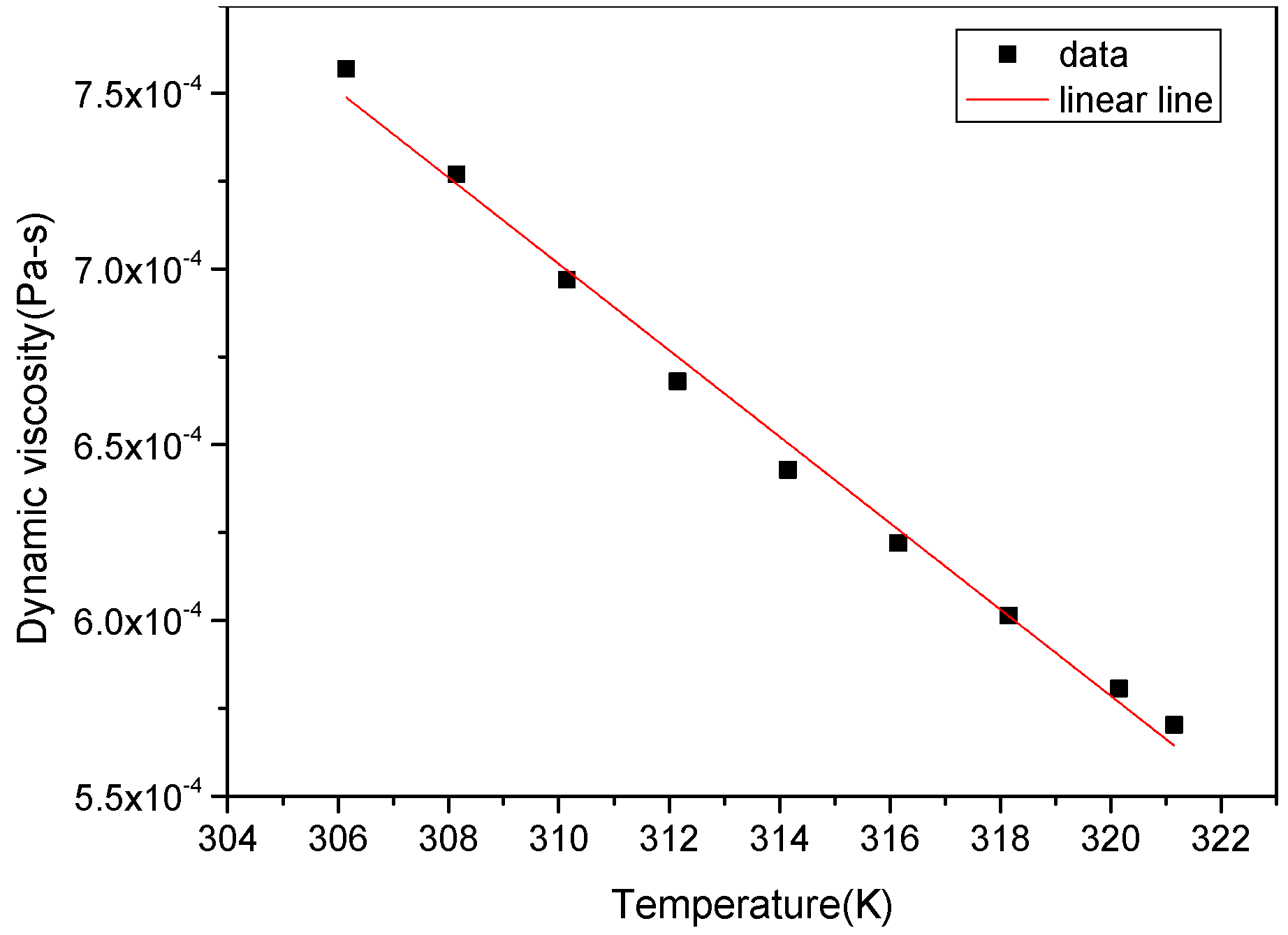
References
- Blondet, E.; Faidy, C. High Cycle Thermal Fatigue in French PWR. In Proceedings of the ASME 10th International Conference on Nuclear Engineering, Arlington, VA, USA, 14–18 April 2002; Volume 1, pp. 429–436. [Google Scholar] [CrossRef]
- Gelineau, O.; Escaravage, C.; Simoneau, J.P.; Faidy, C. High cycle thermal fatigue: Experience and state of the art in French LMFRs. In Proceedings of the SMiRT16, Washington, DC, USA, 12–17 August 2001. Paper ID 1311. [Google Scholar]
- Simoneau, J.P.; Noe, H.; Menant, B. Large eddy simulation of mixing between hot and cold sodium flows—Comparison with experiments. In Proceedings of the 7th International Meeting on Nuclear Reactor Thermal Hydraulics (NURETH-7), Saratoga, CA, USA, 10–15 September 1995; pp. 1324–1332. [Google Scholar]
- Wakamatsu, M.; Hirayama, H.; Kimura, K.; Ogura, K.; Shiina, K.; Tanimoto, K.; Mizutani, J.; Minami, Y.; Moriya, S.; Madarame, H. Study on high-cycle fatigue evaluation for thermal striping in mixing tees with hot and cold water (1). In Proceedings of the 11th International Conference on Nuclear Engineering, Tokyo, Japan, 20–23 April 2003; pp. 479–480, Paper ID ICONE11-36208. [Google Scholar] [CrossRef]
- Kamide, H.; Igarashi, M.; Kawashima, S.; Kimura, N.; Hayashi, K. Study on mixing behavior in a tee piping and numerical analyses for evaluation of thermal striping. Nucl. Eng. Des. 2009, 239, 58–67. [Google Scholar] [CrossRef]
- Frank, T.; Lifante, C.; Prasser, H.M.; Menter, F. Simulation of turbulent and thermal mixing in T-junctions using URANS and scale-resolving turbulence models in ANSYS CFX. Nucl. Eng. Des. 2010, 240, 2313–2328. [Google Scholar] [CrossRef] [Green Version]
- Hu, L.W.; Kazimi, M.S. LES benchmark study of high cycle temperature fluctuations caused by thermal striping in a mixing tee. Int. J. Heat Fluid Flow 2006, 27, 54–64. [Google Scholar] [CrossRef]
- Odemark, Y.; Green, T.M.; Angele, K.; Westin, J.; Alavyoon, F.; Lundström, S. High-cycle thermal fatigue in mixing tees: New Large-Eddy Simulations validated against new data obtained by PIV in Vattenfall experiment. In Proceedings of the ICONE17Proceedings, Brussels, Belgium, 12–16 July 2009. [Google Scholar]
- Tanaka, M.; Miyake, Y. Numerical Investigation on Thermal Striping Phenomena in a T-Junction Piping System. In Proceedings of the 2014 22nd International Conference on Nuclear Engineering, Prague, Czech Republic, 7–11 July 2014. [Google Scholar] [CrossRef]
- Utanohara, Y.; Nakamura, A.; Miyoshi, K.; Kasahara, N. Numerical simulation of long-period fluid temperature fluctuation at a mixing tee for the thermal fatigue problem. Nucl. Eng. Des. 2016, 305, 639–652. [Google Scholar] [CrossRef]
- Lee, J.I.; Hu, L.W.; Saha, P.; Kazimi, M.S. Numerical analysis of thermal striping induced high cycle thermal fatigue in a mixing tee. Nucl. Eng. Des. 2009, 239, 833–839. [Google Scholar] [CrossRef]
- Jayaraju, S.T.; Komen, E.M.J.; Baglietto, E. Suitability of wall-functions in large eddy simulation for thermal fatigue in a T-junction. Nucl. Eng. Des. 2010, 240, 2544–2554. [Google Scholar] [CrossRef]
- Kuhn, S.; Braillard, O.; Ničeno, B.; Prasser, H.M. Computational study of con-jugate heat transfer in T-junctions. Nucl. Eng. Des. 2010, 240, 1548–1557. [Google Scholar] [CrossRef]
- Zeng, C.; Li, C.W. A hybrid RANS-LES model for combining flows in open-channel T-junctions. J. Hydrodyn. Ser. B 2010, 22, 154–159. [Google Scholar] [CrossRef]
- Krumbein, B.; Termini, V.; Jakirlić, S.; Tropea, C. Flow and heat transfer in cross-stream type T-junctions: A computational study. Int. J. Heat Fluid Flow 2018, 71, 179–188. [Google Scholar] [CrossRef]
- Chang, C.Y.; Jakirlić, S.; Dietrich, K.; Basara, B.; Tropea, C. Swirling flow in a tube with variably-shaped outlet orifices: An LES and VLES study. Int. J. Heat Fluid Flow 2014, 49, 28–42. [Google Scholar] [CrossRef]
- Wilcox, D.C. Turbulence Modeling for CFD, 3rd ed.; DCW Industries Inc.: La Canada, CA, USA, 2006. [Google Scholar]
- Hanjalic, K.; Launder, B. Modelling Turbulence in Engineering and the Environment; Cambridge University Press: Cambridge, UK, 2011. [Google Scholar]
- Menter, F.R. Best Practice: Scale-Resolving Simulations in ANSYS CFD; ANSYS Germany GmbH: Berlin, Germany, 2012; pp. 1–70. [Google Scholar]
- Spalart, P.R.; Jou, W.; Strelets, M.; Allmaras, S. Comments on the feasibility of LES for wings, and on a hybrid RANS/LES approach. In Proceedings of the First AFOSR International Conference on DNS/LES, Ruston, LA, USA, 4–8 August 1997. [Google Scholar]
- Davidson, L.; Billson, M. Hybrid LES-RANS using synthesized turbulent fluctuations for forcing in the interface region. Int. J. Heat Fluid Flow 2006, 27, 1028–1042. [Google Scholar] [CrossRef]
- Kang, D.G.; Na, H.; Lee, C.Y. Detached eddy simulation of turbulent and thermal mixing in a T-junction. Ann. Nucl. Energy 2019, 124, 245–256. [Google Scholar] [CrossRef]
- Pope, S.B. Turbulent Flows. Turbul. Flows 2000, 12, 806. [Google Scholar]
- ANSYS. ANSYS FLUENT-17 User Manual; ANSYS Inc.: Canonsburg, PA, USA, 2017. [Google Scholar]
- Shur, M.L.; Spalart, P.R.; Strelets, M.K.; Travin, A.K. A Hybrid RANS-LES Approach with Delayed-DES and Wall-Modelled LES Capabilities. Int. J. Heat Fluid Flow 2008, 29, 1638–1649. [Google Scholar] [CrossRef]
- Smagorinsky, J. General Circulation Experiments with the Primitive Equations. I. The Basic Experiment. Mon. Weather Rev. 1963, 91, 99–164. [Google Scholar] [CrossRef]
- Piomelli, U.; Moin, P.; Ferziger, J.H. Model Consistency in Large-Eddy Simulation of Turbulent Channel Flow. Phys. Fluids 1988, 31, 1884–1894. [Google Scholar] [CrossRef]
- Moon, J.H.; Lee, S.; Lee, J.; Lee, S.H. Numerical study on subcooled water jet impingement cooling on superheated surfaces. Case Stud. Therm. Eng. 2022, 32, 101883. [Google Scholar] [CrossRef]
- Wang, J.; Gong, J.; Kang, X.; Zhao, C.; Hooman, K. Assessment of RANS turbulence models on predicting supercritical heat transfer in highly buoyant horizontal flows. Case Stud. Therm. Eng. 2022, 34, 102057. [Google Scholar] [CrossRef]
- Georgiadis, N.J.; Yoder, D.A.; Towne, C.S.; Engblom, W.A.; Bhagwandin, V.A.; Power, G.D.; Lankford, D.W.; Nelson, C.C. Wind-US Code Physical Modeling Improvements to Complement Hypersonic Testing and Evaluation. In Proceedings of the 47th AIAA Aerospace Sciences Meeting including The New Horizons Forum and Aerospace Exposition, Orlando, FL, USA, 5–8 January 2009. [Google Scholar]
- Fang, X.; Yang, Z.; Wang, B.C.; Tachie, M.F.; Bergstrom, D.J. Large-eddy simulation of turbulent flow and structures in a square duct roughened with perpendicular and V-shaped ribs. Phys. Fluids 2017, 29, 065110. [Google Scholar] [CrossRef]
- Addad, Y.; Gaitonde, U.; Laurence, D.; Rolfo, S. Optimal Unstructured Meshing for Large Eddy Simulations. In Quality and Reliability of Large-Eddy Simulations; Springer: Dordrecht, The Netherlands, 2008. [Google Scholar]
- Kuczaj, A.K.; Komen, E.; Loginov, M.S. Large-Eddy Simulation study of turbulent mixing in a T-junction. Nucl. Eng. Des. 2010, 240, 2116–2122. [Google Scholar] [CrossRef] [Green Version]
- Mathey, F.; Cokljat, D.; Bertoglio, J.P.; Sergent, E. Specification of LES Inlet Boundary Condition Using Vortex Method. In Proceedings of the 4th International Symposium on Turbulence, Heat and Mass Transfer, Antalya, Turkey, 12–17 October 2003. [Google Scholar]
- Maekawa, I. Numerical diffusion in single-phase multi-dimensional thermal-hydraulic analysis. Nucl. Eng. Des. 1990, 120, 323–339. [Google Scholar] [CrossRef]
- Chen, M.S.; Hsieh, H.E.; Ferng, Y.M.; Pei, B.S. Experimental Observations of Thermal Mixing Characteristics in T-junction Piping. Trans. Am. Nucl. Soc. 2012, 107, 1409–1412. [Google Scholar] [CrossRef]
- Lin, C.H.; Chen, M.S.; Ferng, Y.M. Investigating thermal mixing and reverse flow characteristics in a T-junction by way of experiments. Appl. Therm. Eng. Des. Processes Equip. Econ. 2016, 99, 1171–1182. [Google Scholar] [CrossRef]
- Chuang, G.Y.; Ferng, Y.M. Experimentally investigating the thermal mixing and thermal stripping characteristics in a T-junction. Appl. Therm. Eng. Des. Processes Equip. Econ. 2017, 113, 1585–1595. [Google Scholar] [CrossRef]
- Chuang, G.Y.; Ferng, Y.M. Investigating effects of injection angles and velocity ratios on thermal-hydraulic behavior and thermal striping in a T-junction. Int. J. Therm. Sci. 2018, 126, 74–81. [Google Scholar] [CrossRef]
- Wu, B.; Yin, Y.; Lin, M.; Wang, L.; Zeng, M.; Wang, Q. Mean pressure distributions around a circular cylinder in the branch of a T-junction with/without vanes. Appl. Therm. Eng. 2015, 88, 82–93. [Google Scholar] [CrossRef]
- Smith, B.L.; Mahaffy, J.H.; Angele, K. A CFD benchmarking exercise based on flow mixing in a T-junction. Nucl. Eng. Des. 2013, 264, 80–88. [Google Scholar] [CrossRef]
- Höhne, T. Scale resolved simulations of the OECD/NEA–Vattenfall T-junction benchmark. Nucl. Eng. Des. 2014, 269, 149–154. [Google Scholar] [CrossRef] [Green Version]
- Miyoshi, K.; Nakamura, A.; Utanohara, Y.; Takenaka, N. An investigation of wall temperature characteristics to evaluate thermal fatigue at a T-junction pipe. Mech. Eng. J. 2014, 1, TEP0050. [Google Scholar] [CrossRef] [Green Version]
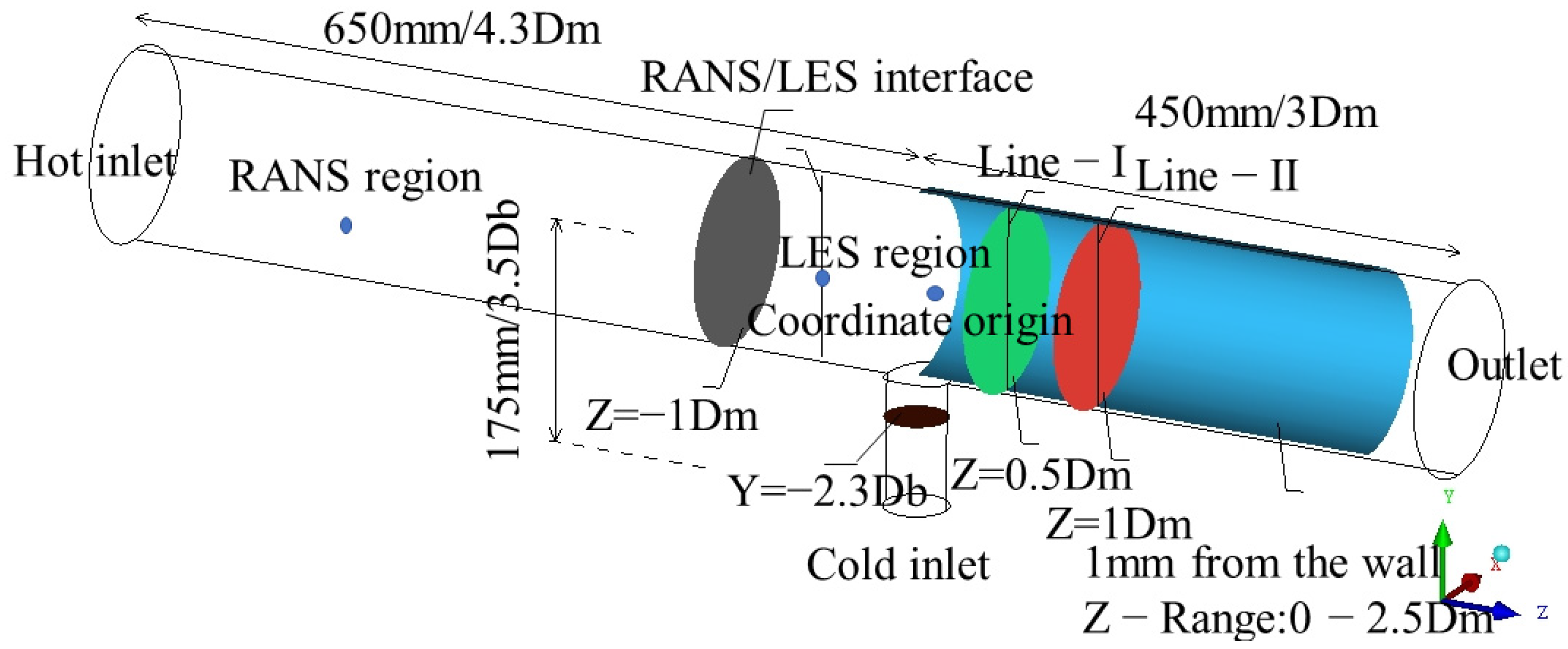
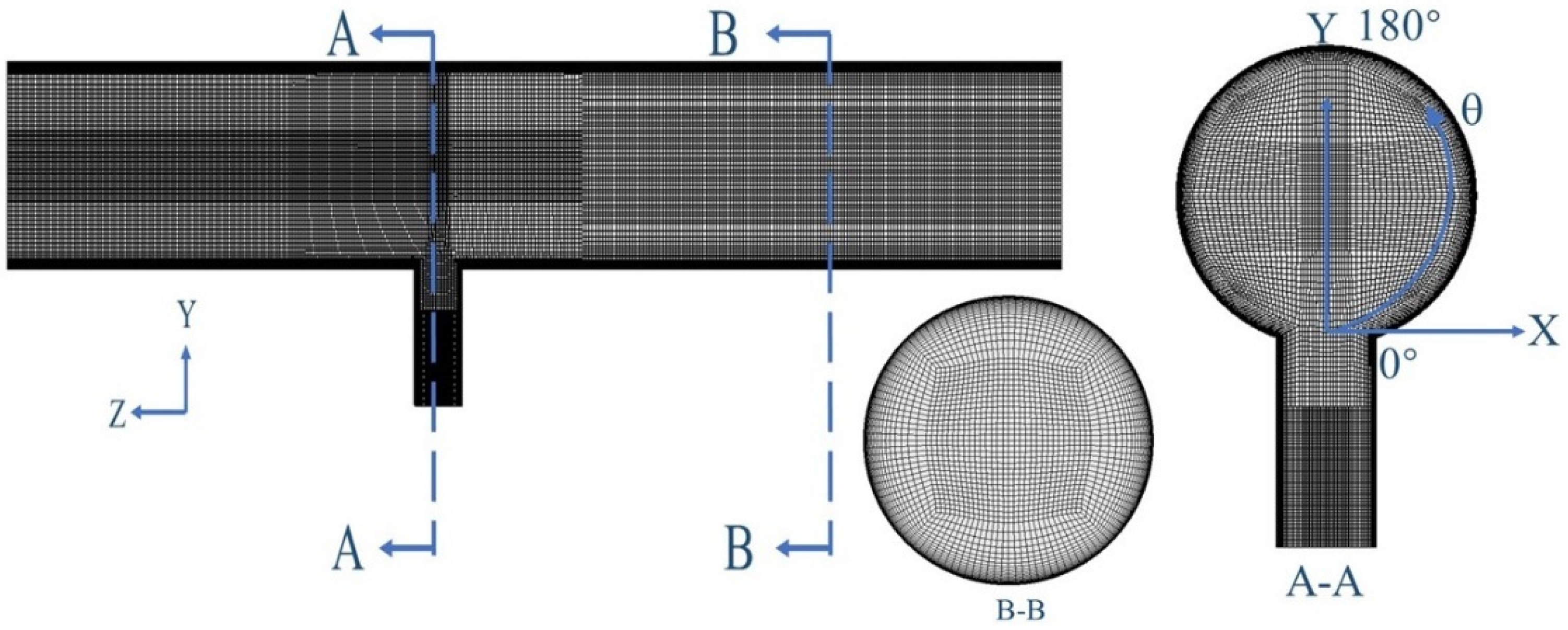


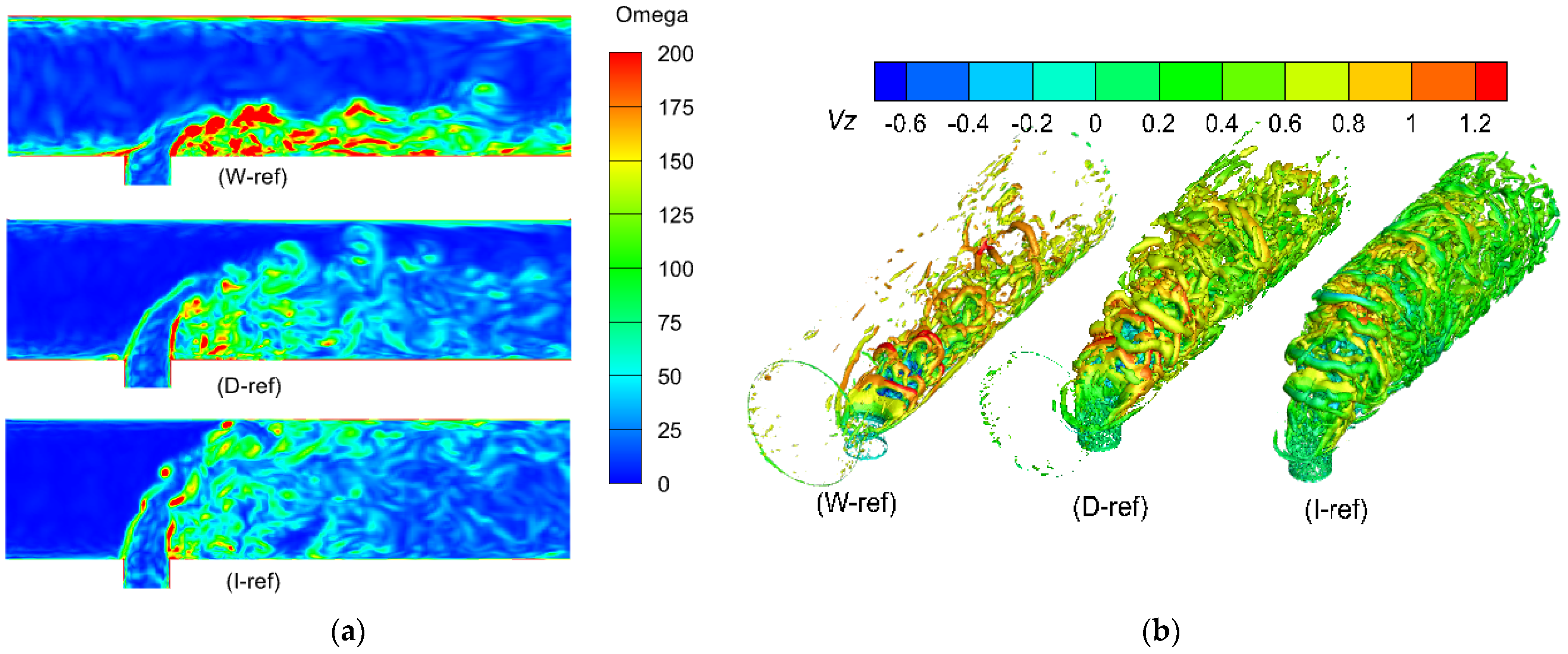
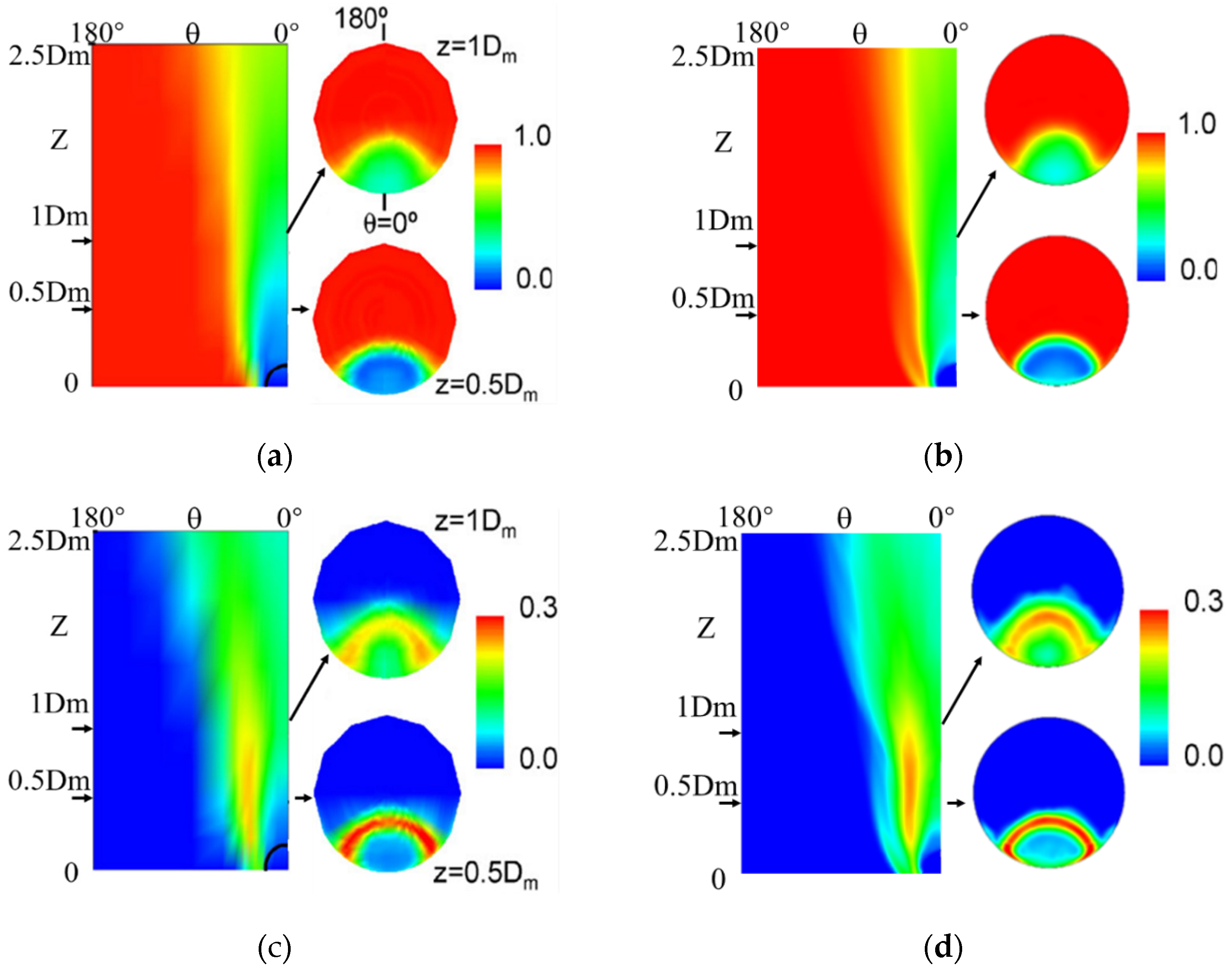
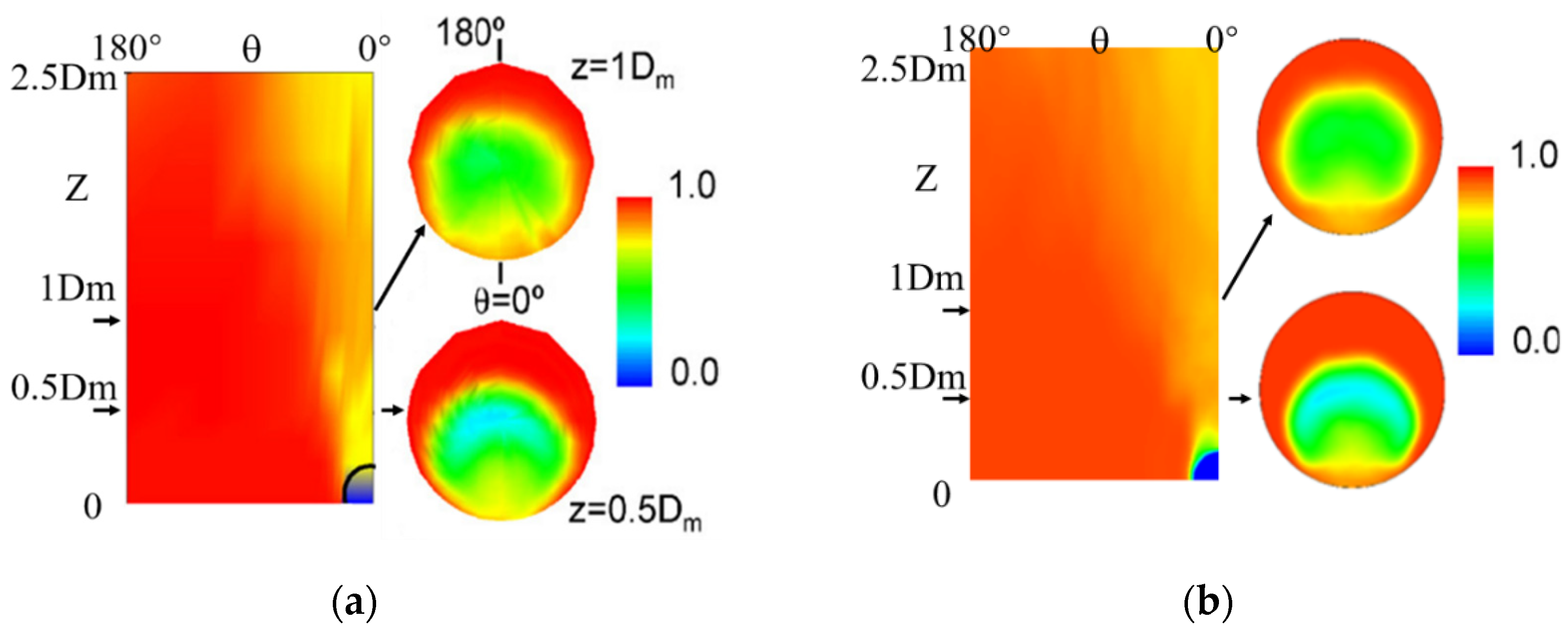
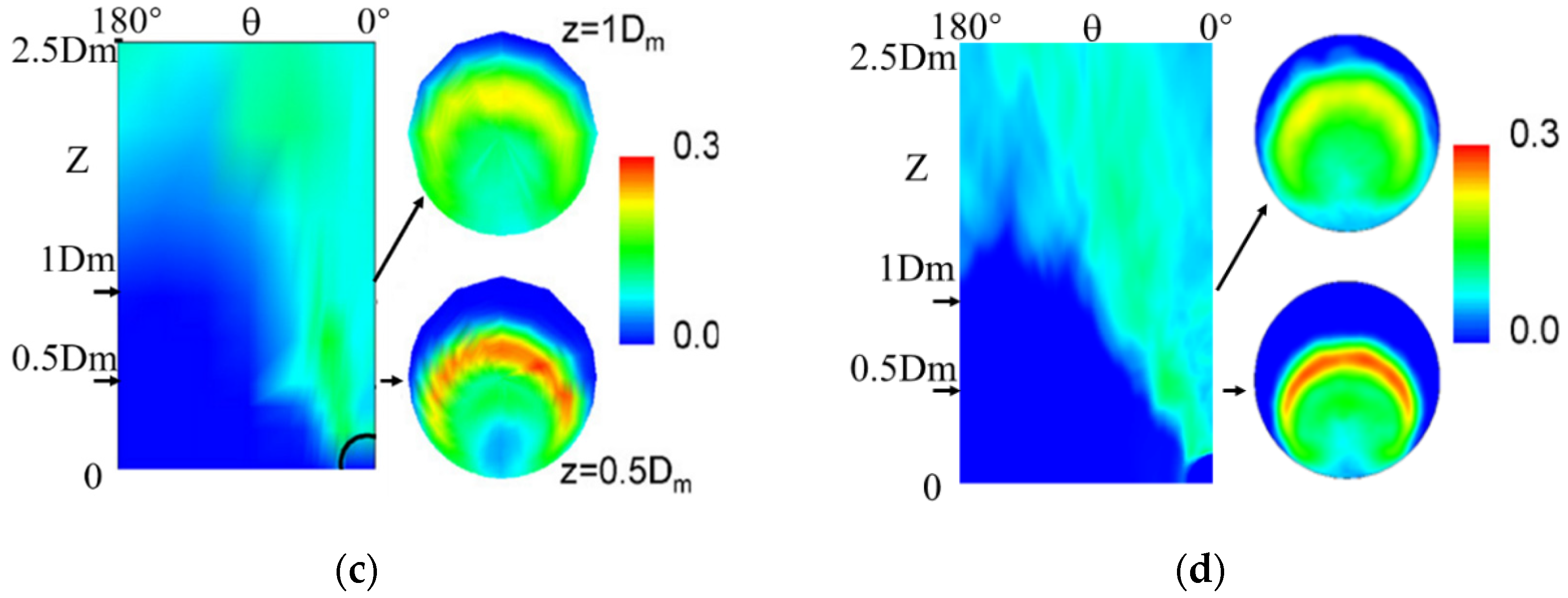
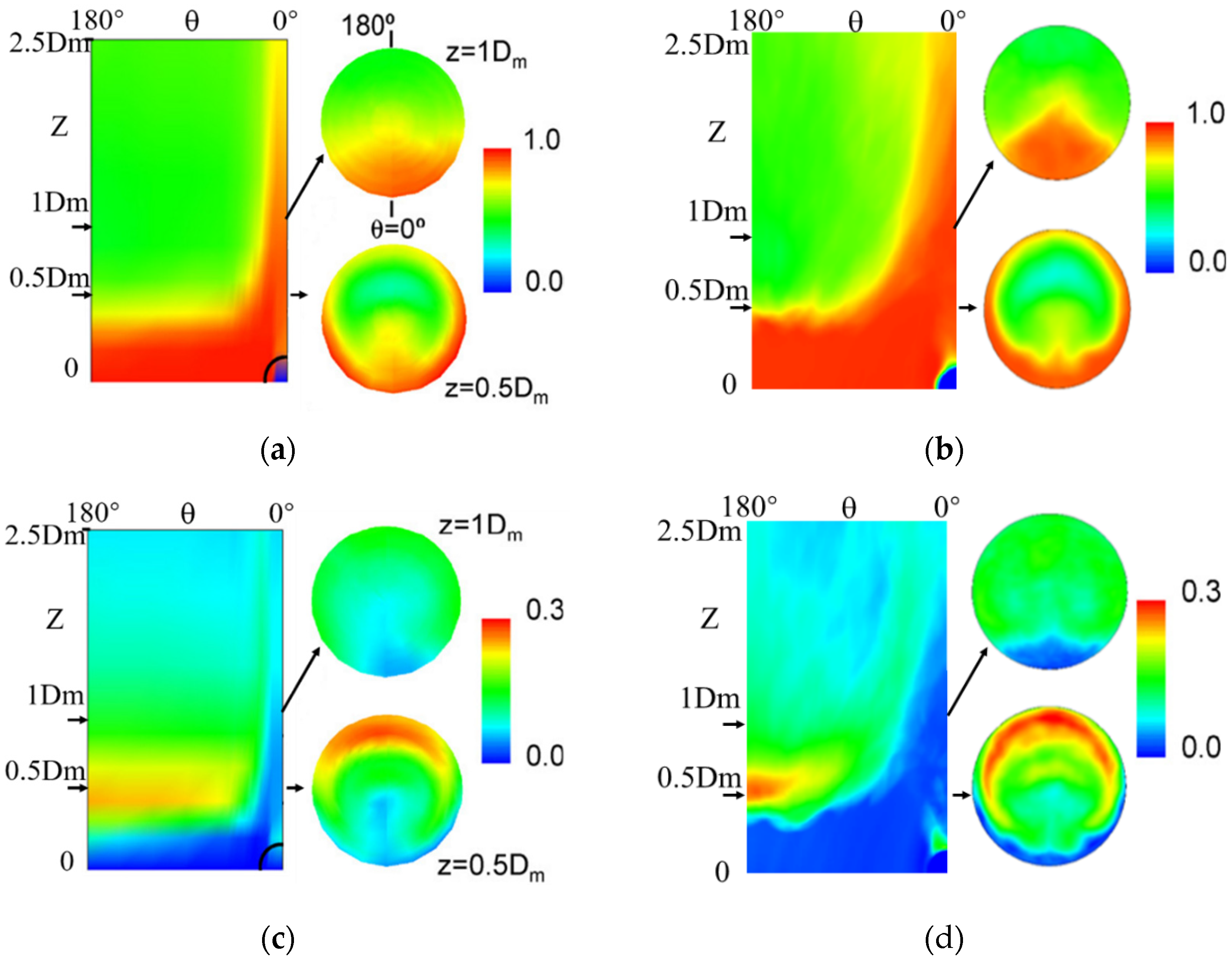
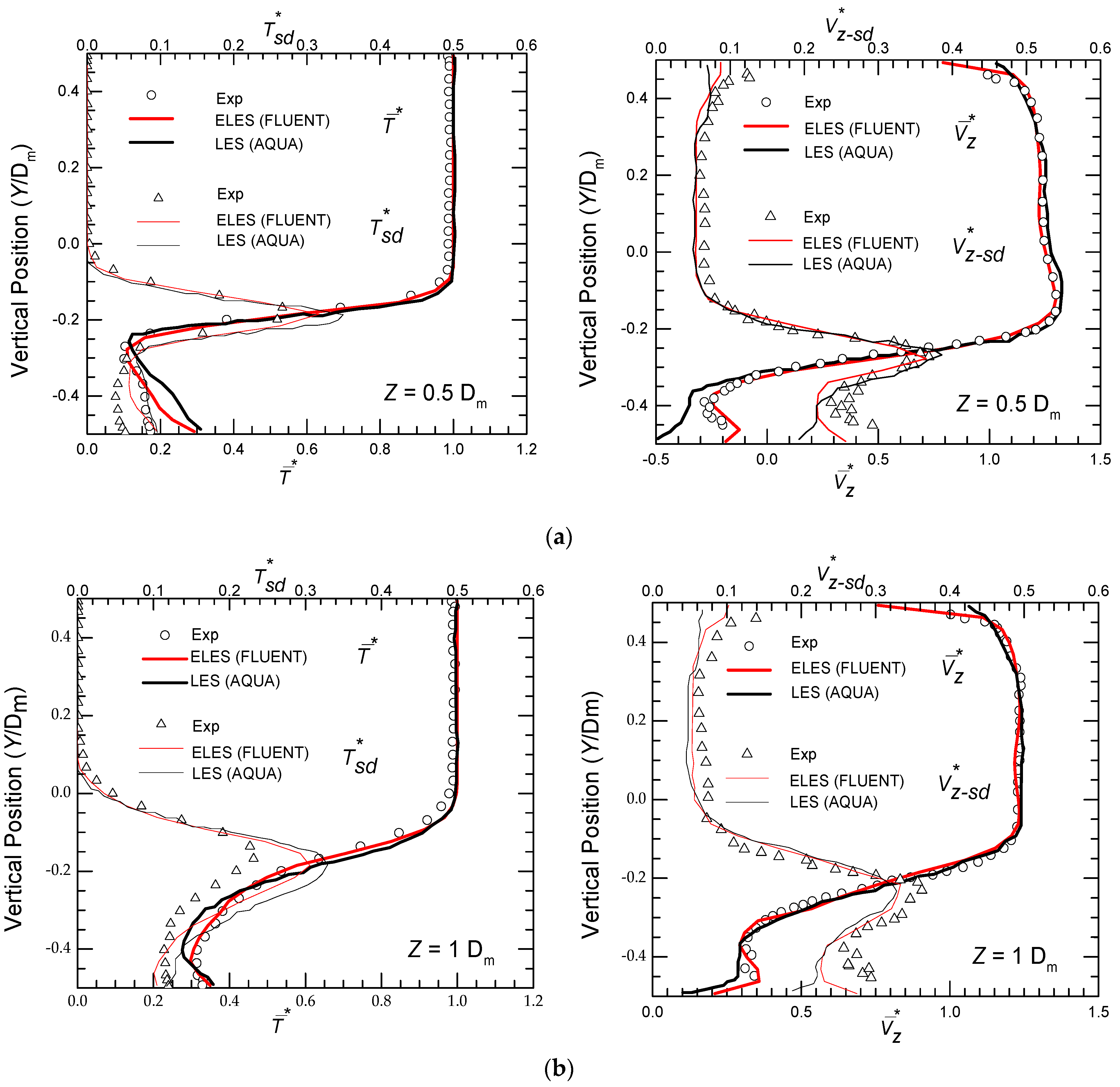
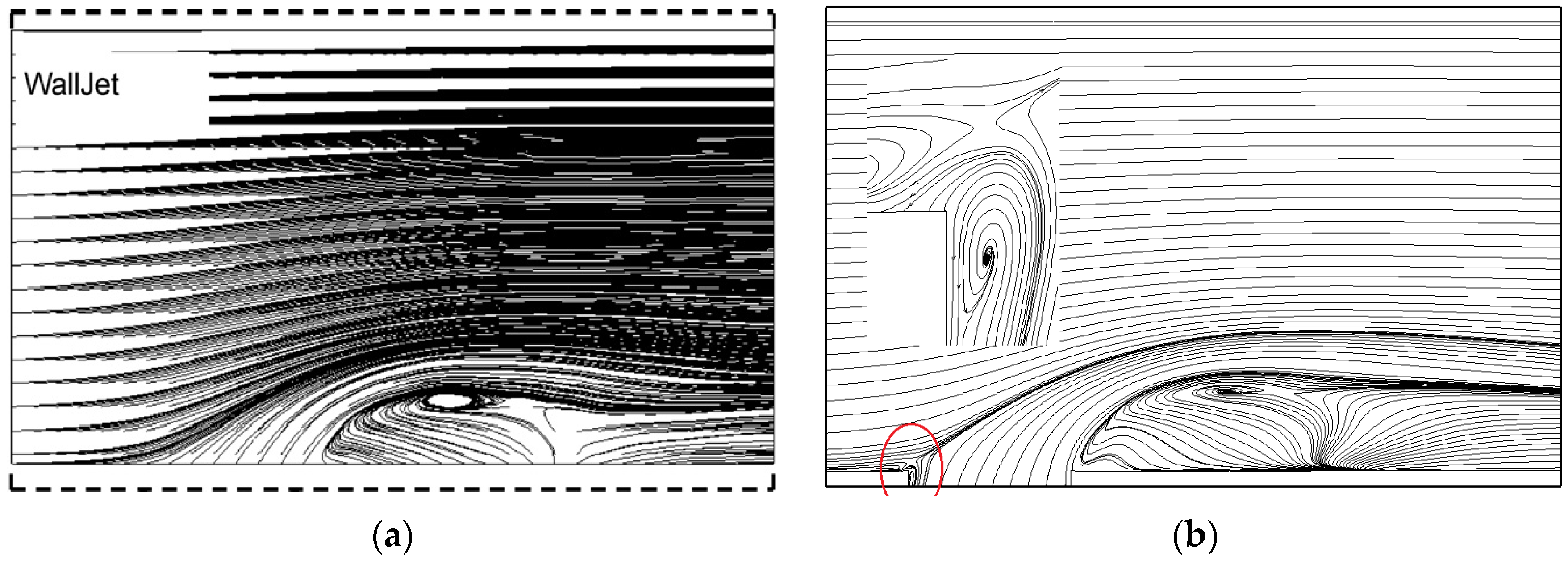
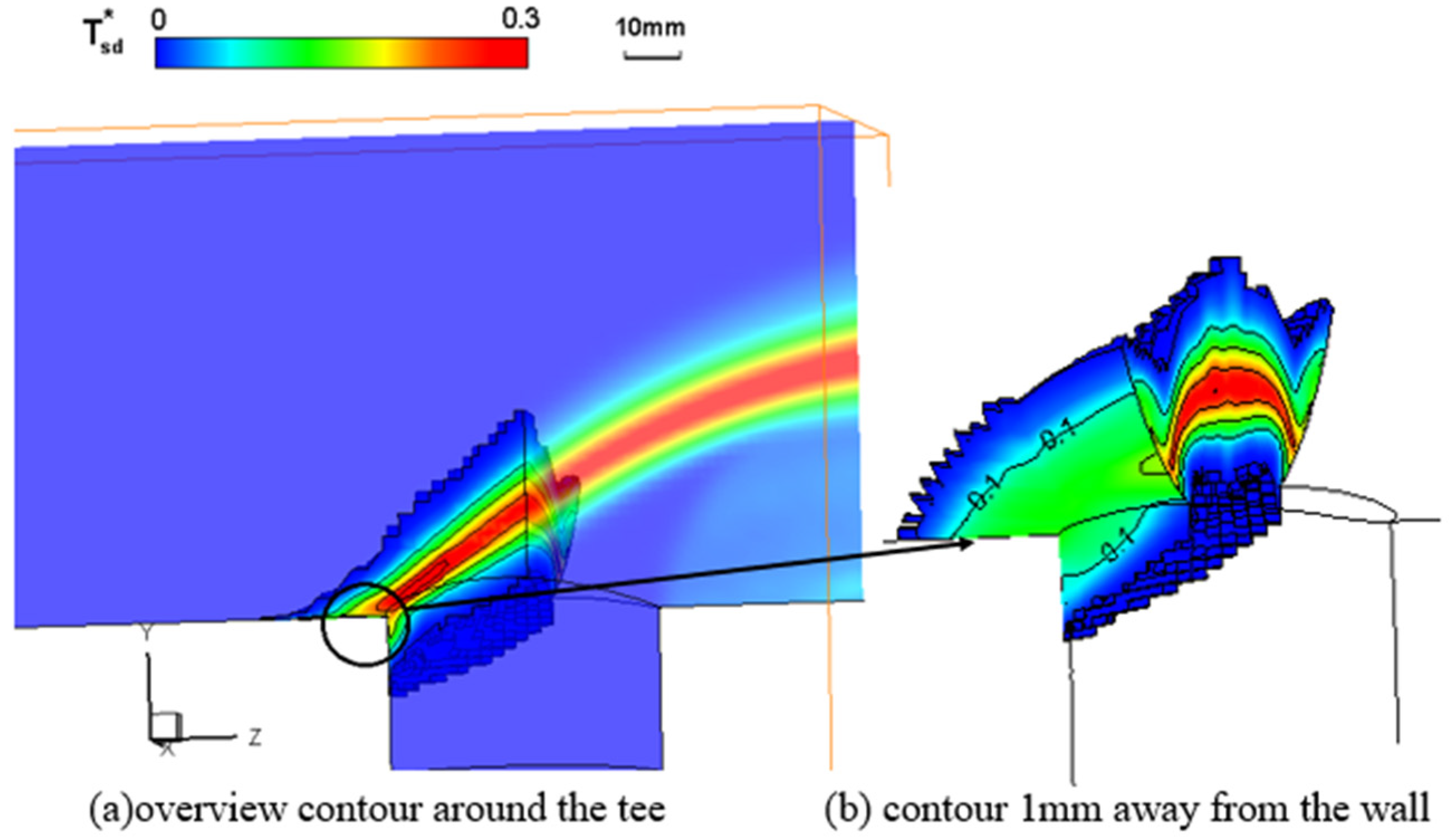
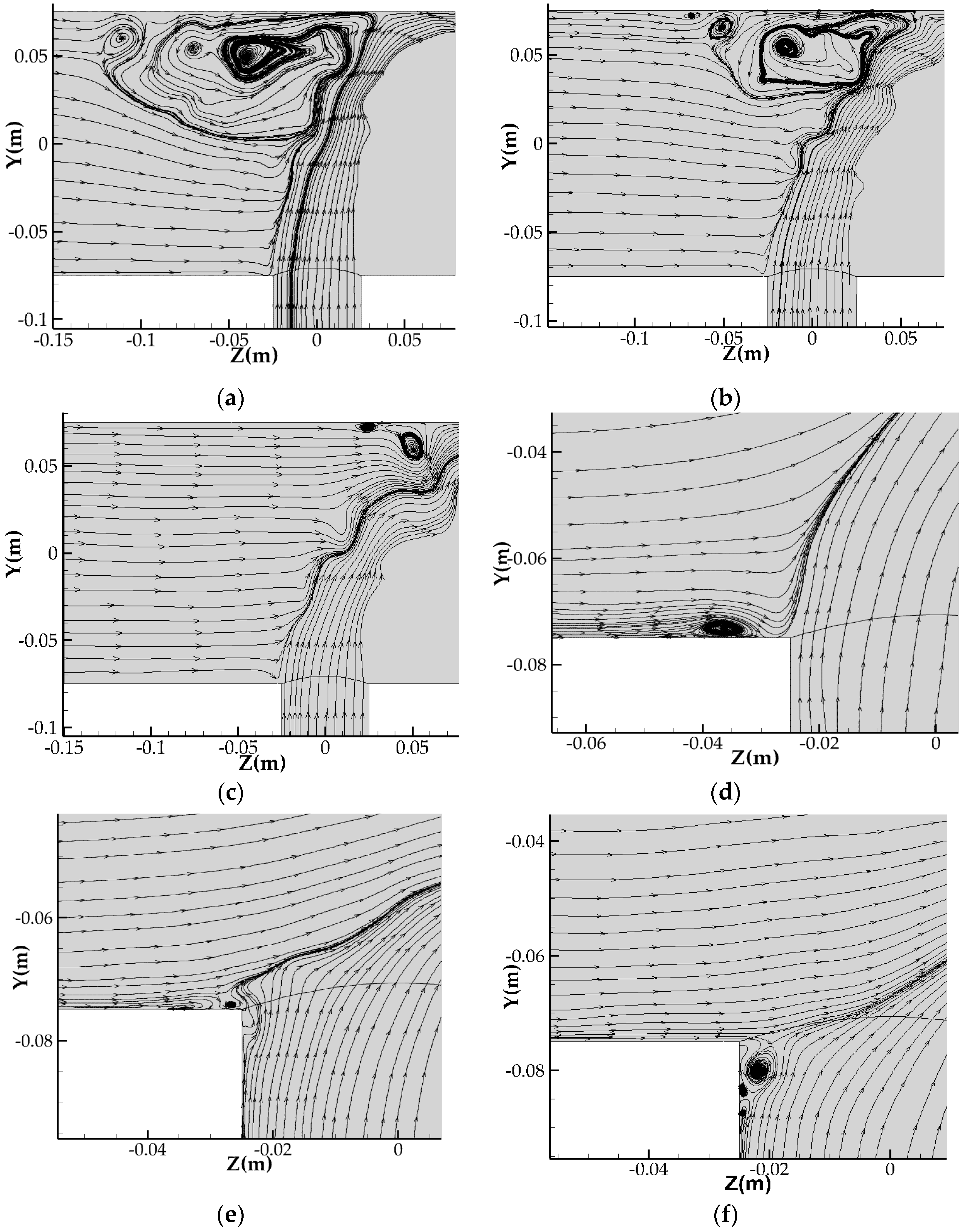
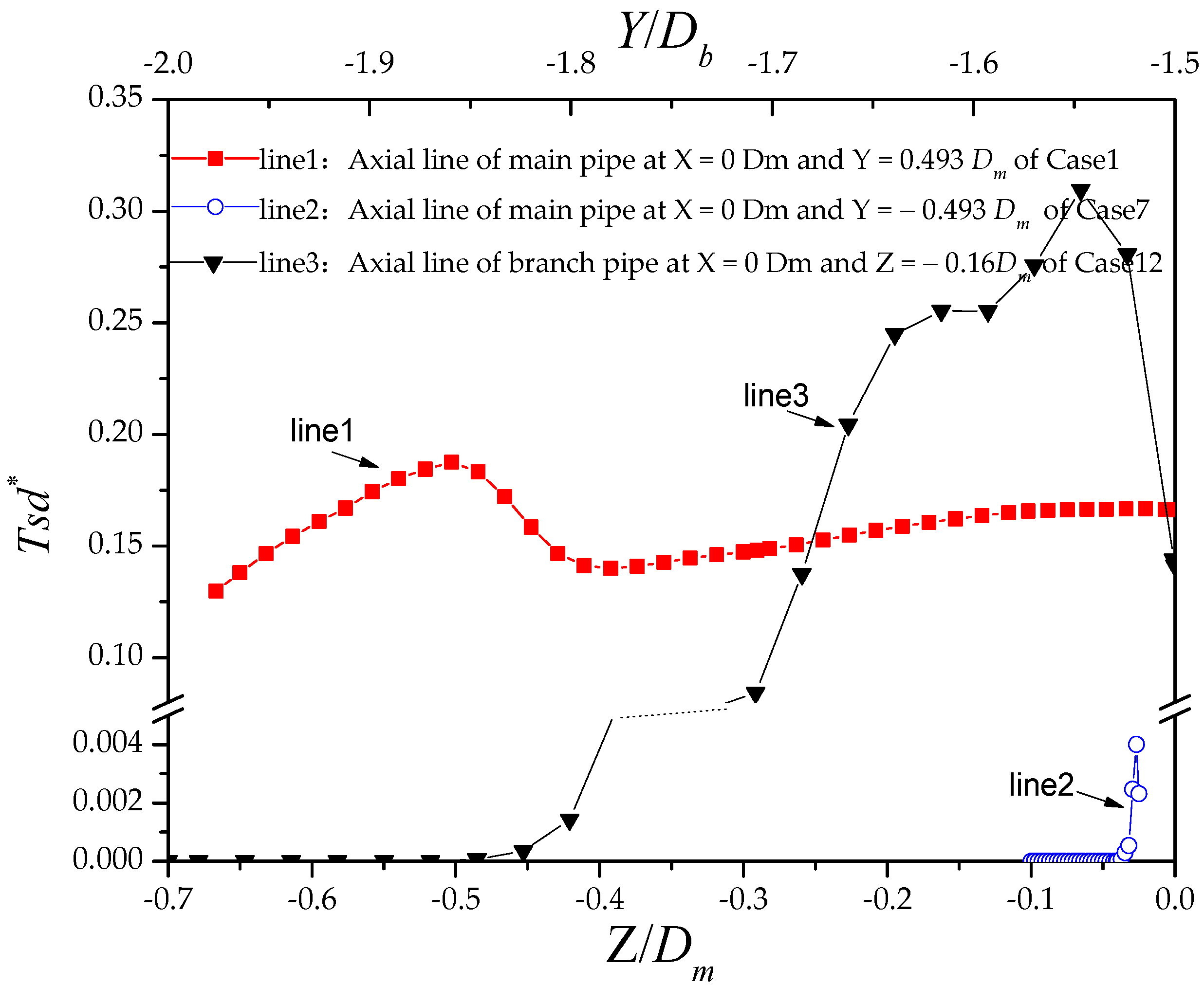
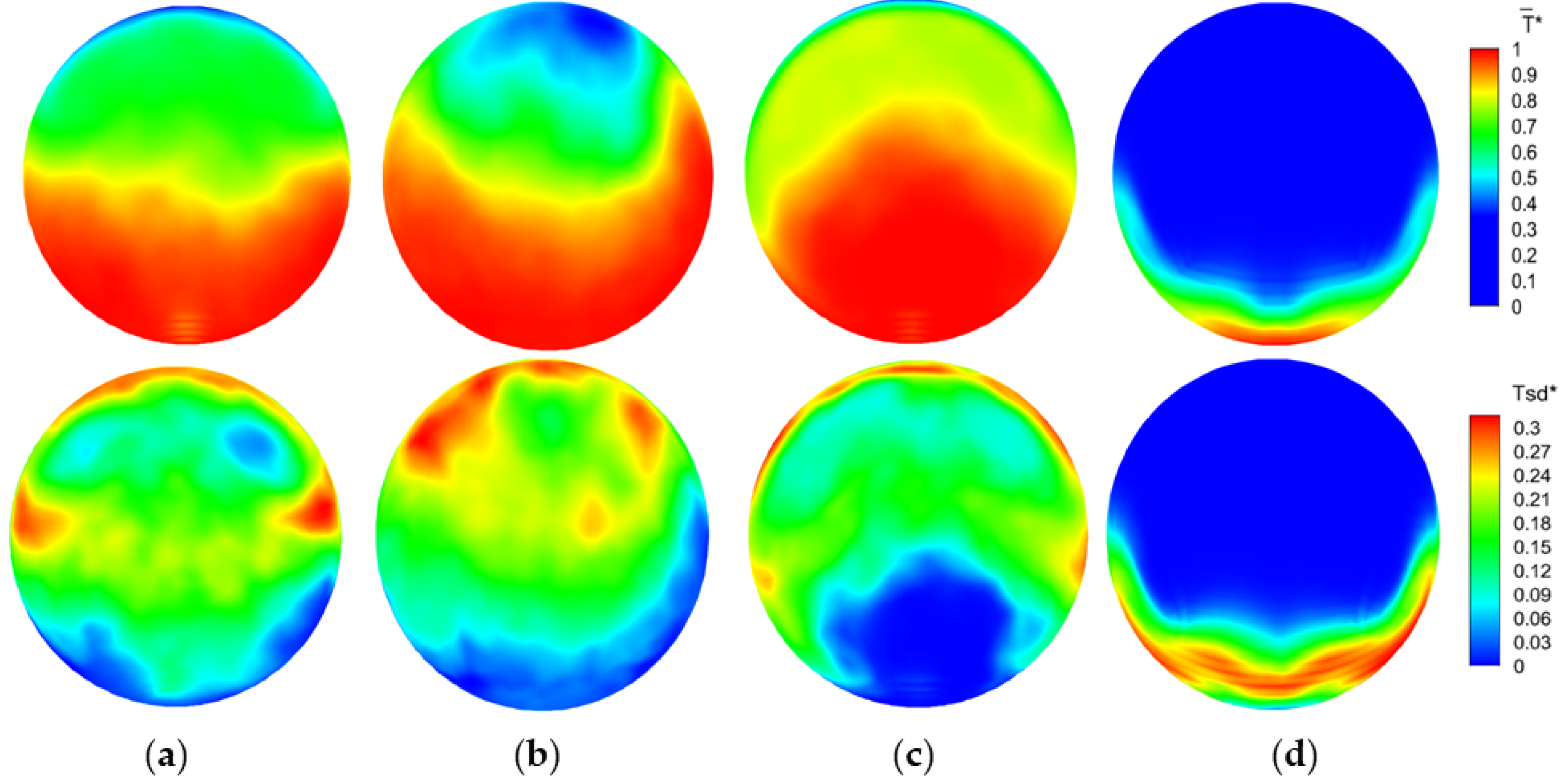

| Case | Average Velocity (m/s) | Momentum Ratio (MR) | Flow Pattern | |
|---|---|---|---|---|
| Main (Vm) | Branch (Vb) | |||
| W-ref | 1.46 | 1 | 8.1 | Wall jet |
| D-ref | 0.46 | 0.8 | Deflecting jet | |
| I-ref | 0.23 | 0.2 | Impinging jet | |
| Case | Treatment near the Wall | Treatment in the Free Shear Layer | Criteria |
|---|---|---|---|
| Case-A | Ny = 30, Δy1 = 0.02, y+ ~ 1 | Δ < 5 | More relaxed requirements put forward by NJ Georgiadis et al. [28] and Equation (21) |
| Case-B | Ny = 60, Δy1 = 1, y+ ~ 50 | Δ < 2.5 | Strict requirements put forward by NJ Georgiadis et al. [28] and Equation (21) |
| Case-C | Ny = 60, Δy1 = 0.02, y+ ~ 1 | Δ < 2.5 | More relaxed requirements put forward by NJ Georgiadis et al. [28] and Equation (21) |
| Case-D | Ny = 80, Δy1 = 0.02, y+ ~ 1 | Δ < 1.5 | Strict requirements put forward by NJ Georgiadis et al. [28] and Equation (21) |
| Numerical Settings | ||
|---|---|---|
| Spatial discretization | Momentum | Bounded central differencing in LES; 2nd order upwind in RANS |
| K & Ω | 2nd order upwind in RANS | |
| Gradients | 1st order upwind | |
| Pressure | 2nd order upwind | |
| Time Discretization | Transient formulation | Bounded second order implicit |
| Time advancement | Iterative time advancement with SIMPLEC scheme | |
| Time step interval | 0.001 (s) | |
| Iteration every 1 time-step | 20 iterations | |
| Models | RANS portion | K-omega SST |
| LES portion | WMLES | |
| Precursor simulations | RANS domain | K-omega SST |
| Case | Average Main Velocity (Vm) (m/s) | Momentum Ratio (MR) | Flow Pattern |
|---|---|---|---|
| Case1 | 0.11 | 0.05 | Impinging jet |
| Case2 | 0.16 | 0.1 | Impinging jet |
| Case3 | 0.20 | 0.15 | Impinging jet |
| Case4 | 0.23 | 0.2 | Impinging jet |
| Case5 | 0.46 | 0.8 | Deflecting jet |
| Case6 | 1.46 | 8.1 | Wall jet |
| Case7 | 1.74 | 11.5 | Wall jet |
| Case8 | 1.76 | 11.8 | Wall jet |
| Case9 | 1.78 | 12 | Wall jet |
| Case10 | 1.85 | 13 | Wall jet |
| Case11 | 1.95 | 14.5 | Wall jet |
| Case12 | 2.9 | 32 | Wall jet |
Publisher’s Note: MDPI stays neutral with regard to jurisdictional claims in published maps and institutional affiliations. |
© 2022 by the authors. Licensee MDPI, Basel, Switzerland. This article is an open access article distributed under the terms and conditions of the Creative Commons Attribution (CC BY) license (https://creativecommons.org/licenses/by/4.0/).
Share and Cite
Sun, C.; Wang, H.; Jiang, Y.; Zou, Z.; Zhu, F. Numerical Simulation of Non-Isothermal Mixing Flow Characteristics with ELES Method. Appl. Sci. 2022, 12, 7381. https://doi.org/10.3390/app12157381
Sun C, Wang H, Jiang Y, Zou Z, Zhu F. Numerical Simulation of Non-Isothermal Mixing Flow Characteristics with ELES Method. Applied Sciences. 2022; 12(15):7381. https://doi.org/10.3390/app12157381
Chicago/Turabian StyleSun, Chengbin, Hexu Wang, Yanlong Jiang, Zhixin Zou, and Faxing Zhu. 2022. "Numerical Simulation of Non-Isothermal Mixing Flow Characteristics with ELES Method" Applied Sciences 12, no. 15: 7381. https://doi.org/10.3390/app12157381
APA StyleSun, C., Wang, H., Jiang, Y., Zou, Z., & Zhu, F. (2022). Numerical Simulation of Non-Isothermal Mixing Flow Characteristics with ELES Method. Applied Sciences, 12(15), 7381. https://doi.org/10.3390/app12157381





